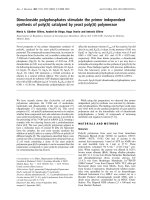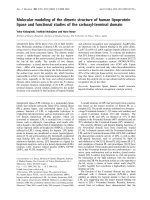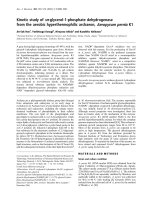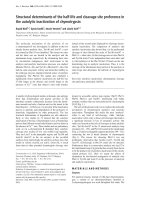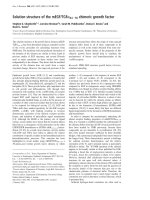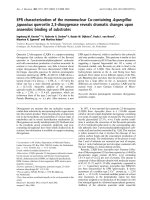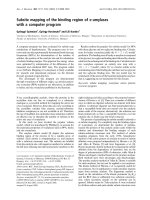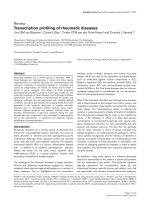Báo cáo y học: " Mycotic aneurysm of the popliteal artery secondary to Streptococus pneumoniae: a case report and review of the literature" doc
Bạn đang xem bản rút gọn của tài liệu. Xem và tải ngay bản đầy đủ của tài liệu tại đây (335.18 KB, 5 trang )
BioMed Central
Open Access
Page 1 of 5
(page number not for citation purposes)
Journal of Medical Case Reports
Case report
Mycotic aneurysm of the popliteal artery secondary to
Streptococus pneumoniae: a case report and review of the literature
Shane D Killeen*
1
, Noel O'Brien
1
, Martin J O'Sullivan
1
, George Karr
2
, H
Paul Redmond
1
and Gregory J Fulton
1
Address:
1
Departments of General Surgery, Cork University Hospital, Wilton, Cork, Ireland and
2
Neurosurgery, Cork University Hospital, Wilton,
Cork, Ireland
Email: Shane D Killeen* - ; Noel O'Brien - ; Martin J O'Sullivan - ;
George Karr - ; H Paul Redmond - ; Gregory J Fulton -
* Corresponding author
Abstract
Introduction: Cases of true mycotic popliteal artery aneurysm are rare. Presentation is variable
but invasive and non-invasive investigations collectively facilitate diagnosis and guide operative
procedures. Definitive treatment generally utilizes surgical intervention with excision and
reconstruction using autologous vein graft. Prolonged targeted antibiotic therapy is an important
adjuvant.
Case presentation: We describe the clinical presentation, radiological investigations and
strategies on the management of a 47-year-old Caucasian Irish man who presented with a mycotic
aneurysm of the popliteal artery due to thromboembolisation from Streptococus pneumoniae
endocarditis.
Conclusion: Cases of true mycotic popliteal artery aneurysms are rare. To the best of our
knowledge this is the first documented case of a popliteal artery mycotic aneurysm developing
secondary to Streptococus pneumoniae highlighting the changing profile of causative microorganisms.
Introduction
True mycotic popliteal artery aneurysm is a rare condition
and its presentation is variable. Definitive treatment is
generally characterised by excision and reconstruction
using an autologous vein graft. We describe the clinical
presentation, radiological investigations and manage-
ment strategies employed in the case of a 47-year-old man
who presented with a mycotic aneurysm of the popliteal
artery (MPAA) secondary to thromboembolisation from
Streptococus pneumoniae endocarditis.
Case presentation
A 47-year-old Caucasian Irish man was admitted to our
intensive care unit (ICU) with multiple cerebral infarcts
secondary to septic emboli from Streptococus pneumoniae
endocarditis vegetations. After a prolonged ICU course,
the patient was eventually transferred to the ward with
minimal neurological dysfunction. The patient, however,
developed pain in his right calf 6 weeks after admission.
A clinical examination revealed a pyrexic patient with a
swollen, pulsatile and tender right upper calf mass, palpa-
Published: 10 November 2009
Journal of Medical Case Reports 2009, 3:117 doi:10.1186/1752-1947-3-117
Received: 25 July 2008
Accepted: 10 November 2009
This article is available from: />© 2009 Killeen et al; licensee BioMed Central Ltd.
This is an Open Access article distributed under the terms of the Creative Commons Attribution License ( />),
which permits unrestricted use, distribution, and reproduction in any medium, provided the original work is properly cited.
Journal of Medical Case Reports 2009, 3:117 />Page 2 of 5
(page number not for citation purposes)
ble distal pedal pulses and foot drop (Figure 1). A mycotic
aneurysm of his right popliteal artery (MPAA) was visible
on computer tomography (CT) angiogram. Sepsis-related
renal impairment precluded formal contrast angiography.
Magnetic resonance angiography confirmed the presence
of a large saccular aneurysm of the right below-knee pop-
liteal artery approximately 8 × 9.5 × 8 cm, extending to the
trifurcation with satisfactory inflow and outflow vessels.
The contralateral popliteal artery was normal (Figure 2).
Urgent operative repair involved aneurysm excision and
reconstruction using reversed ipsilateral long saphenous
vein.
A curved incision over the right popliteal fossa revealed a
saccular aneurysm of the below- knee popliteal artery
involving the trifurcation. Proximal control was attained
and the aneurysm opened, exposing a significant amount
of haematoma and thrombus (Figure 3). Samples were
sent for histological and microbiological assessment. The
distal tibioperoneal trunk was identified and a reversed
vein graft was interposed between it and the below-knee
popliteal artery. After the operation, pulses were present
in the posterior tibial and peroneal arteries. The patient's
lower limb sensory deficit improved immediately and the
foot drop resolved slowly.
A femoral angiogram performed 2 weeks after the proce-
dure demonstrated satisfactory graft segment flow (Figure
4). No organism was identified on microbiological assess-
ment and atherosclerosis was not evident on histological
examination. The patient started physiotherapy. Three
Tender, pulsatile mass in the right upper calf consistent with a popliteal aneurysmFigure 1
Tender, pulsatile mass in the right upper calf consist-
ent with a popliteal aneurysm.
Magnetic resonance image scan demonstrating a saccular aneurysm of the right below-knee popliteal arteryFigure 2
Magnetic resonance image scan demonstrating a sac-
cular aneurysm of the right below-knee popliteal
artery.
Aneurysm of the below-knee popliteal artery with proximal control and evacuation of intraluminal thrombusFigure 3
Aneurysm of the below-knee popliteal artery with
proximal control and evacuation of intraluminal
thrombus.
Journal of Medical Case Reports 2009, 3:117 />Page 3 of 5
(page number not for citation purposes)
months after presentation, he could already move on his
own and had normal ankle brachial indices.
Discussion
According to Wilson's widely held classification, mycotic
aneurysms are strictly defined as "infected aneurysms
developing in a previously normal artery secondary to
septic embolisation due to bacterial endocarditis" [1].
Thus, although the Dublin surgeon Jolliffe Tufnell
reported the first case of a ruptured infective popliteal
aneurysm in 1885 [2], it was Stengel and Wolferth who
reported the first "mycotic" popliteal artery aneurysm
(MPAA) in 1923 [3].
To date there are fewer than 50 cases of "true" MPAA
reported in the literature. The estimated male-to-female
ratio is 11:3 with an age range of 2 to 81 years with the
mean age of occurrence at 41 years old [1]. This contrasts
with the results of other examinations on the causes of
popliteal aneurysms (49:1, 50-80 years and 61 years,
respectively) [4-8]. MPAA is a consequence of septic
embolisation, usually from bacterial endocarditis,
whereby emboli are lodged in the lumen or vaso vasorum
of normal or abnormal peripheral arteries. This leads to
vessel wall infection and ischemia resulting in medial
destruction and aneurysm formation [3]. The normal
intima is very resistant to infection and, therefore, healthy
arteries are rarely affected unless the organism is very vir-
ulent or the patient is immunocompromised. In less than
50% of reported cases, the causative organism can be
identified from operative specimens as a result of pre-
operative antibiotic therapy [5]. Cases of exotic organisms
Right femoral angiogram demonstrating a patent vein graft extending from the distal popliteal artery to the posterior tibial artery with retrograde filling of the anterior tibial artery via the planter archFigure 4
Right femoral angiogram demonstrating a patent
vein graft extending from the distal popliteal artery
to the posterior tibial artery with retrograde filling of
the anterior tibial artery via the planter arch.
Table 1: Organisms cultured from mycotic popliteal aneurysms
collected through a review of the English language literature
Staphylococcus aureus 5 [5]
Streptococcus viridans 3 [7]
Staphylococcus epidermis 2 [5]
Campylobacter jejuni 2 [12,13]
Streptococcus faecalis 1 [6]
Streptococcus pneumoniae 1*
E. coli 1 [5]
Tuberculosis 1[14]
Salmonella spp 1 [15]
Culture negative 17
*This case.
Journal of Medical Case Reports 2009, 3:117 />Page 4 of 5
(page number not for citation purposes)
are getting more isolated, which probably reflects an aging
and immunocompromised population and increased use
of prosthetic heart valves (Table 1).
MPAA customarily presents as a painful, tender, pulsatile
leg swelling in pyrexic patients with a definitive or unsus-
pected infective focus [7]. Symptoms and signs of
ischemia are often evident, secondary to thrombosis or
rupture, which is a particular complication of popliteal
aneurysms. Presentation may also mimic a deep vein
thrombosis [6].
Although an estimated 3% of non-mycotic popliteal
artery aneurysms can produce neurological symptoms
and signs, possibly due to direct compression or occlusion
of the vasonervorum arising from the popliteal artery [9],
our patient's condition is one of the few documented
cases of MPAA that produced a definitive neurological
defect.
Laboratory studies are unhelpful in diagnosing MPAA and
often indicate a non-specific leukocytosis or increased
erythrocyte sedimentation rate (ESR) and C-reactive pro-
tein (CRP). Blood cultures are positive in only 50% of
reported cases, but negative blood cultures and Gram
stains do not necessarily rule out a mycotic aneurysm
(Table 2).
Non-invasive procedures such as colour-duplex ultra-
sonography, CT and magnetic resonance imaging (MRI)
or angiogram can establish a diagnosis of postoperative
alopecia areata (PAA) and provide information regarding
the size, diameter, morphology (saccular morphology
being suggestive of an infective aetiology) and its relation-
ship to surrounding structures [5].
Angiography, either conventional or digital subtraction, is
important to demonstrate the status of the inflow and
outflow vessels, hence guiding any operative approach
[4,5].
CT and MRI as vessel imaging alternatives can be satisfac-
tory, as in this case where the patient's temporary sepsis-
related renal impairment precluded formal contrast angi-
ography [5].
Ankle brachial index (ABI) measurements provide an
objective, measurable and repeatable index of ischemia.
Broad-spectrum antibiotics should be commenced pre-
operatively and continued for a variable period postoper-
atively. If no causative pathogen is identified, at least two
synergistic agents should be employed. Since there are no
clear guidelines regarding the duration of postsurgical
therapy, a 6-week oral course seems to be a prudent
approach [5,10].
MPAA generally mandates resection and revascularisation
[4-8,10]. The techniques and anatomic approaches in
treating mycotic popliteal aneurysms can be different
from those employed for their non-mycotic counterparts.
There is no consensus in the literature with regards to
approach, with medial and posterior approaches being
equally utilized [4,5,10]. Infective aetiology prohibits the
use of prosthetic conduits to restore flow and autologous
long saphenous vein grafts were the overwhelming con-
duit of choice, either as in situ vessels or reversed superfi-
cial vein from the ipsilateral or contralateral lower (or
upper) limb [5,10]. Deep leg veins, however, may be a via-
ble alternative to long saphenous vein [11]).
The literature includes only a few reports of amputation,
failure of reconstructive procedure and the need for sec-
Table 2: Presentation of mycotic popliteal aneurysms collected through a review of English language literature
Swelling in the popliteal fossa 33 (100%)
Fever 28 (85%)
Elevated erythrocyte sedimentation rate/C-reactive protein 25 (77%)
Leucocytosis 24 (72%)
Ischemia 12 (37%)
Deep vein thrombosis 5 (14%)
Rupture 2 (6%)
Foot drop 1 (3%)*
*This case.
Publish with BioMed Central and every
scientist can read your work free of charge
"BioMed Central will be the most significant development for
disseminating the results of biomedical research in our lifetime."
Sir Paul Nurse, Cancer Research UK
Your research papers will be:
available free of charge to the entire biomedical community
peer reviewed and published immediately upon acceptance
cited in PubMed and archived on PubMed Central
yours — you keep the copyright
Submit your manuscript here:
/>BioMedcentral
Journal of Medical Case Reports 2009, 3:117 />Page 5 of 5
(page number not for citation purposes)
ondary reconstruction or amputation, which probably
reflects an unwillingness to publish perceived treatment
failures. It is thus reasonable to assume a total limb sal-
vage rate, a 5-year patency rate and a primary and/or sec-
ondary amputation rate that are at least comparable with,
if not worse than, those of non-mycotic popliteal aneu-
rysms (in the region of 60-72%, 50-86%, and 18-27.5%
and/or 28-40%, respectively [5]).
Conclusion
Mycotic popliteal artery aneurysm is a rare but potentially
devastating condition. A high index of suspicion is there-
fore necessary. Invasive and non-invasive investigations
facilitate diagnosis and guide operative procedures. Surgi-
cal intervention with excision and reconstruction using an
autologous vein graft is the method of choice. Prolonged
antibiotic therapy should initially be broad spectrum
until pathogen identification can allow targeted therapy.
Abbreviations
ABI: ankle brachial index; CT: computer tomography;
ESR: erythrocyte sedimentation rate; CRP: C-reactive pro-
tein; ICU: intensive care unit; MPAA: mycotic aneurysm of
the popliteal artery; PAA: postoperative alopecia areata;
Consent
Written informed consent was obtained from the patient
for publication of this case report and any accompanying
images. A copy of the written consent is available for
review by the Editor-in-Chief of this journal.
Competing interests
The authors declare that they have no competing interests.
Authors' contributions
SK retrieved all clinical data and conducted the literature
review. NOB and MOS supplied the radiological images
and also contributed to the literature review. HPR and GK
were major contributors to the overall writing of the man-
uscript. GF contributed to the literature review, performed
the procedure described, supplied the clinical images and
conducted the specimen analysis. All authors read and
approved the final manuscript.
References
1. Wilson SE, Van Wagenen P, Passaro E Jr: Arterial infection. Curr
Probl Surg 1978, 15:5.
2. Tufnell J: On the influence of vegetations on the valves of the
heart, in the production of secondary arterial disease. Q J
Med Sci (Dublin) 1853, 15:371-382.
3. Stengel A, Wolferth CC: Mycotic (bacterial) aneurysms of intra-
vascular origin. Arch Intern Med 1923, 31:527-554.
4. Mann CF, Barker SG: Occluded mycotic popliteal aneurysm
secondary to infective endocarditis. Eur J Vasc Endovasc Surg
1999, 18(2):169-170.
5. Davidovic LB, Slobodan LI, Kostic DM, Ilijas CS: Popliteal artery
aneurysms. World J Surg 1998, 22:812-817.
6. Safar HA, Cina CS: Ruptured mycotic aneurysm of the pop-
liteal artery. J Cardiovasc Surg 2001, 42(2):237-240.
7. Bonds JW Jr, Fabian TC: Surgical treatment of mycotic pop-
liteal artery aneurysm: a case report and review of litera-
ture. Surgery 1985, 98:979-982.
8. Gifford RW, Hines EA, Janes JM: An analysis and follow up study
of one hundred popliteal aneurysms. Surgery 1953, 33:284.
9. Beaudry Y, Stewart JD, Erret L: Distal sciatic nerve compression
by a popliteal artery aneurysm. Can J Neurol Sci 1989, 16:352.
10. Wilson P, Fulford P, Abraham J, Smyth JV, Dodd PD, Walker MG:
Ruptured infected popliteal artery aneurysm. Ann Vasc Surg
1995, 9:497-499.
11. Benjamin ME, Cohn EJ, Purtill WA, Hanna DJ, Lilly MP, Flinn WR:
Arterial reconstruction with deep leg veins for the treat-
ment of mycotic aneurysms. J Vasc Surg 1999, 30(6):1004-1015.
12. Baty V, Hoen B, Selton-Suty C, Schuhmacher H, Peiffert B, Danchin
N, Cherrier F: Campylorbacter fetus
endocarditis manifested
by a popliteal mycotic aneurysm. Presse Med 1998,
27(8):357-358.
13. Goëau-Brissonnière O, Hardy C, Renier JF, Delorme G, Patel JC:
[Surgical treatment of infectious aneurysm of the popliteal
artery. Description of a case caused by Campylobacter jejuni
and a review of the literature]. J Chir (Paris) 1990,
127(40):223-226.
14. Jebara VA, Nasnas R, Achouh PE, Tabet G, Kassab R, Karem B, Rassi
I: Mycotic aneurysm of the popliteal artery secondary to
tuberculosis. A case report and review of the literature. Tex
Heart Inst J 1998, 52(2):136-139.
15. Alonso-Bartolome P, Alonso Valle H, Aurrecoeechea E, Acha O,
Blanco R: Mycotic (infected) aneurysm of the popliteal artery
and arthritis following Salmonella bacteraemia. Clin Exp Rheu-
matol 2001, 19(3):325-328.
